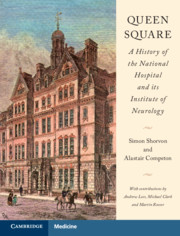There can be few neurologists, if any, unaware of the signification of “Queen Square” (although here in Liverpool it is synonymous with a bus station). It used to be said that there were two types of Neurologist – those who trained at Queen Square, and those who wished they had trained at Queen Square. Certainly many of the former and quite possibly many of the latter may be interested to consult this long awaited and limited edition history of an institution which some may still regard as the Neurology “mother ship”.
The founding of the National Hospital in 1860 occurred at a time of developing interest in Neurology as an independent specialty (e.g. the work of Charcot and Vulpian at the Salpêtrière in Paris; Silas Weir Mitchell at the Turner’s Lane Hospital in Philadelphia). Its origins were as a philanthropic endeavour funded by charity with unpaid honorary clinical appointments, from which has eventually evolved a research-intensive medical specialism. The journey documented here has evidently been a bumpy ride, with the hospital near closure on more than one occasion. Whilst the clinical contributions emanating from Queen Square are well known, the bureaucratic history provided here is certainly less familiar, and serves to remind us that the power struggle between clinicians and managers is not unique to our own times.
Great though the pantheon of QS alumni is, this book is no mere hagiography: although the greats are individually attended to (e.g. Hughlings Jackson, Ferrier, Gowers, Horsley, Holmes, Kinnier Wilson, Critchley, Symonds), this is also a carefully contextualised history, with much recourse to the minutes of the Board of Management and reference to contemporary historical events (hence, it is more than might have been anticipated from the book’s title alone). The world wars in particular did much to shape the institution’s history. The chapter on development of Neurology in the United Kingdom more widely is a welcome counterpoint; of course, Queen Square trainees accounted for much of the initial spread of neurological services.
This is a fascinating history, well told, with a uniformity of style despite the dual authorship and the (unspecified) contributions of three others (Andrew Lees, Michael Clark, Martin Rossor). The text is supplemented with footnotes, some quite extensive (e.g. biographical sketches of some of the notable, but not stellar, QS staff), black and white illustrations (some very evocative, such as the entrance hall where one sat before interview in the Boardroom, p41; the blackboards in the lecture theatre, p135; A-room, p458-9). There are occasional anecdotes, consistently engaging (e.g. Carmichael’s self-experimentation on testicular pain, p441n4, was particularly eye-watering – researchers were made of stern stuff in those days!) and authorial asides.
It would be neglecting a reviewer’s duty to forego a few minor criticisms, however nit-picking they may appear. There are occasional typographical and factual errors (particularly egregious: “Single Proton [sic] Emission Computed Tomography, p399; the date given for Anita Harding’s graduation, 1995, is in fact the year she died, p474; “winter of discontent” ascribed to 1973/4, rather than 1978/9, p503n14); many seem to be in the footnotes. I was disappointed that in discussing Gowers as a possible source for Arthur Conan Doyle’s Sherlock Holmes story The Resident Patient, the reference (p58n16) was to Lees’ paper (Brain 2015;138:2103-8) but without mention of what I believe to be the original formulation of Holmes as Gowers (The Sherlock Holmes Journal 1992;20(4):128-30; Lees does not cite this paper, either) by Robin Howard and Hugh Willison, both of whom were working at QS at the time. The minutiae of ward life and the patient perspective are also absent, since unlikely to have been recorded for the benefit of posterity.
I found this book an immensely enjoyable read. The authors have produced a work which will stand as the definitive history for many decades. They deserve our thanks and congratulations for their labours. It is a book which I shall certainly return to in the future.
ACNR
